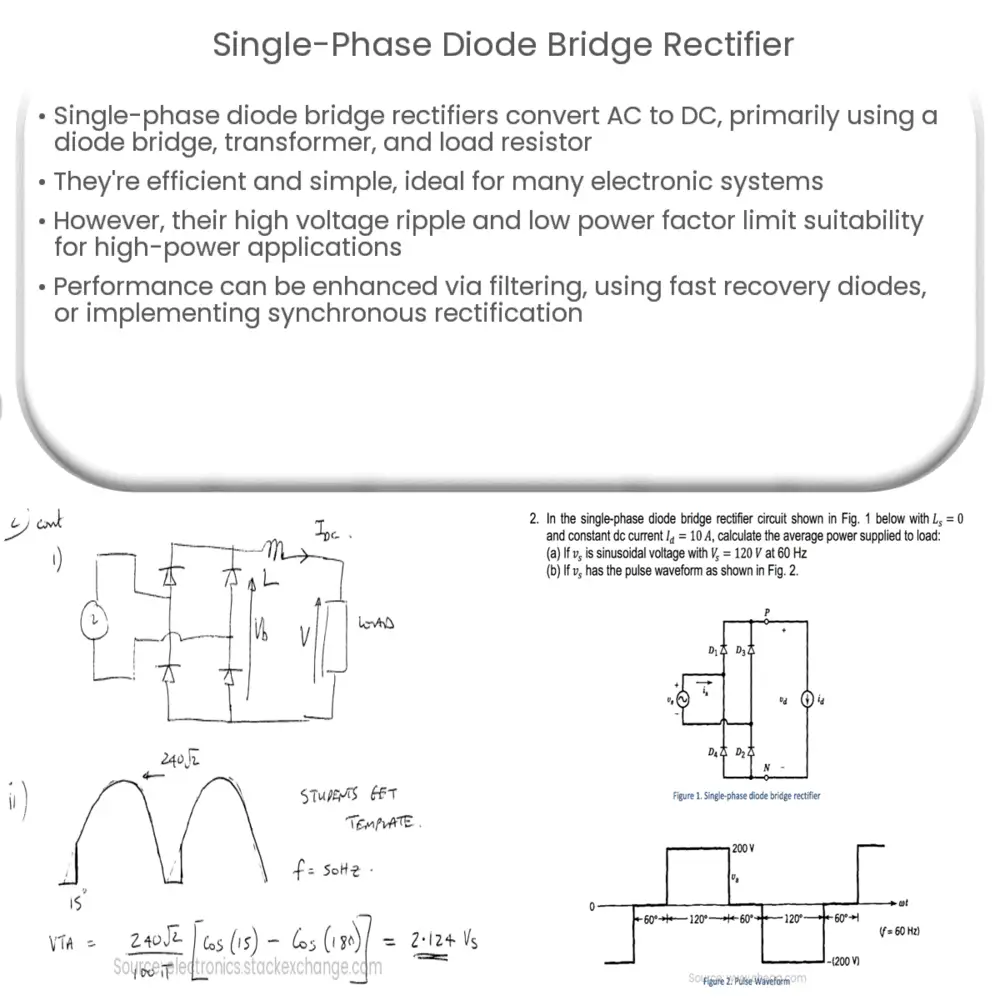A single-phase diode bridge rectifier is an essential component that converts AC to DC, offering simple design, high efficiency, and broad application use.

Single-phase Diode Bridge Rectifier: An Overview
Introduction
A single-phase diode bridge rectifier is a widely used electronic component that efficiently converts alternating current (AC) to direct current (DC). This type of rectifier is found in a variety of applications, including power supplies for electronic devices, battery charging systems, and motor drives. This article will provide an overview of the single-phase diode bridge rectifier, including its working principle, main components, and advantages.
Working Principle
The primary function of a single-phase diode bridge rectifier is to convert an input AC voltage into a unidirectional output DC voltage. The conversion process is achieved through a series of diodes arranged in a bridge configuration. The diodes in the bridge circuit work as switches that direct the flow of current in a single direction, ensuring that the output voltage remains positive regardless of the polarity of the input AC voltage.
During each half cycle of the input AC voltage, two diodes within the bridge become forward-biased, allowing current to flow through them, while the other two diodes become reverse-biased, blocking current flow. This results in a pulsating DC voltage at the output, with the frequency of the output voltage being double that of the input AC voltage. To obtain a smoother DC output voltage, a filtering capacitor can be added in parallel to the load resistor.
Main Components
A single-phase diode bridge rectifier consists of the following main components:
- Diode Bridge: This is the core component of the rectifier and consists of four diodes connected in a bridge configuration. The diode bridge is responsible for converting the AC input voltage into a pulsating DC output voltage.
- Transformer: Typically, a step-down transformer is used to reduce the input AC voltage to a lower level suitable for the specific application. The transformer also provides electrical isolation between the input and output circuits.
- Load Resistor: The load resistor represents the device or circuit that consumes the rectified DC voltage. The value of the load resistor determines the amount of current that flows through the rectifier circuit.
- Filtering Capacitor (Optional): The filtering capacitor is connected in parallel with the load resistor to reduce voltage ripple and produce a smoother DC output voltage. The capacitance value and the load resistor value influence the output voltage ripple and the time constant of the filtering process.
Advantages
Single-phase diode bridge rectifiers offer several advantages, including:
- Simple Design: The rectifier circuit is relatively simple, consisting of only four diodes and a few passive components. This simplicity makes it easy to design, build, and maintain.
- High Efficiency: The diode bridge rectifier provides efficient conversion of AC to DC, with minimal power loss due to its low component count and the use of diodes as switching devices.
- Wide Range of Applications: Due to its versatility and ease of implementation, the single-phase diode bridge rectifier is widely used in various applications such as power supplies, battery chargers, and motor drives.
Disadvantages
Despite the numerous advantages, single-phase diode bridge rectifiers also have some limitations:
- High Voltage Ripple: The output voltage of a single-phase diode bridge rectifier contains significant voltage ripple, which may require additional filtering to achieve a smooth DC output voltage for sensitive applications.
- Low Power Factor: Single-phase diode bridge rectifiers have a low power factor, which can lead to increased apparent power demand and reduced efficiency in certain applications, particularly when supplying inductive loads.
- Not Suitable for High-Power Applications: Due to the limitations of diodes and the relatively high voltage ripple, single-phase diode bridge rectifiers are not ideal for high-power applications. In such cases, three-phase bridge rectifiers or other more advanced topologies may be more suitable.
Improving Performance
There are several methods to improve the performance of single-phase diode bridge rectifiers:
- Filtering: Adding a capacitor or an inductor-capacitor (LC) filter in parallel with the load resistor can significantly reduce the output voltage ripple, providing a smoother DC output voltage.
- Using Fast Recovery Diodes: Replacing conventional diodes with fast recovery diodes can minimize reverse recovery losses and improve the efficiency of the rectifier circuit.
- Employing Synchronous Rectification: Replacing the diodes with power MOSFETs and using a synchronous rectification technique can improve both the efficiency and the power factor of the rectifier circuit, making it suitable for higher-power applications.
Conclusion
In summary, the single-phase diode bridge rectifier is a fundamental electronic component that provides efficient conversion of AC to DC. Its simplicity, high efficiency, and wide range of applications make it a popular choice for many electronic systems. However, its limitations, such as high voltage ripple and low power factor, may require additional measures to improve performance for specific applications. By employing filtering techniques, using fast recovery diodes, or implementing synchronous rectification, the performance of single-phase diode bridge rectifiers can be significantly enhanced, making them suitable for a broader array of applications.

